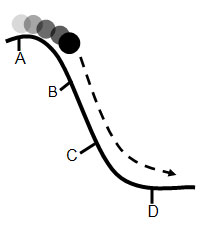
The amount of kinetic energy in an object depends on its —
A. mass and velocity
Correct!
B. temperature and mass
Incorrect. Kinetic energy is affected by mass but not temperature.
C. velocity and temperature
Incorrect. Kinetic energy is affected by velocity but not temperature.
D. mass and position
Incorrect. Kinetic energy is affected by mass but not position.
Which of the following statements are true about potential and kinetic energy?
A. The amount of kinetic energy in an object depends on its mass and position while the amount of potential energy in an object depends on its speed and position.
Incorrect. The amount of potential energy in an object depends on its mass and position while the amount of kinetic energy in an object depends on its speed and position.
B. The amount of potential energy in an object depends on its mass and position while the amount of kinetic energy in an object depends on its speed and position.
Correct!
C. The amount of potential energy in an object depends on its mass and speed while the amount of kinetic energy in an object depends on its mass and position.
Incorrect. The amount of potential energy in an object depends on its mass and position while the amount of kinetic energy in an object depends on its speed and position.
D. The amount of potential energy in an object depends on its temperature and position while the amount of kinetic energy in an object depends on its speed and temperature.
Incorrect. The amount of potential energy in an object depends on its mass and position while the amount of kinetic energy in an object depends on its speed and position.
Which of the following has the most potential energy?
A. A person on a bike at the top of a hill
Incorrect. A person on a bike would have potential energy but is there an answer choice that has more potential energy?
B. A person on a bike riding down the hill
Incorrect. A person riding on a bike would have more kinetic energy than potential energy.
C. A car at the top of a hill
Correct!
D. A car speeding down the hill
Incorrect. A car speeding down the hill would have a lot of kinetic energy and little potential energy.
The diagram below shows a ball rolling down a hill. Based on the diagram which of the following is a true statement?

A. At point A, the ball has the most kinetic energy and at point C, it has the most potential energy.
Incorrect. At point A the ball has the most potential energy and at point D it has the most kinetic energy.
B. At point A, the ball has the most potential energy and at point D it has the most kinetic energy.
Correct!
C. At point B, the ball has the most potential energy and at point C, it has the most kinetic energy.
Incorrect. At point A, the ball has the most potential energy and at point D it has the most kinetic energy.
D. At point A, the ball has the most kinetic energy and at point D it has the most potential energy.
Incorrect. At point A, the ball has the most potential energy and at point D it has the most kinetic energy.